CD, CD Çalar, DVD, DVD Çalar, SACD, LP, Plak Çeşitleri ve Fiyatları
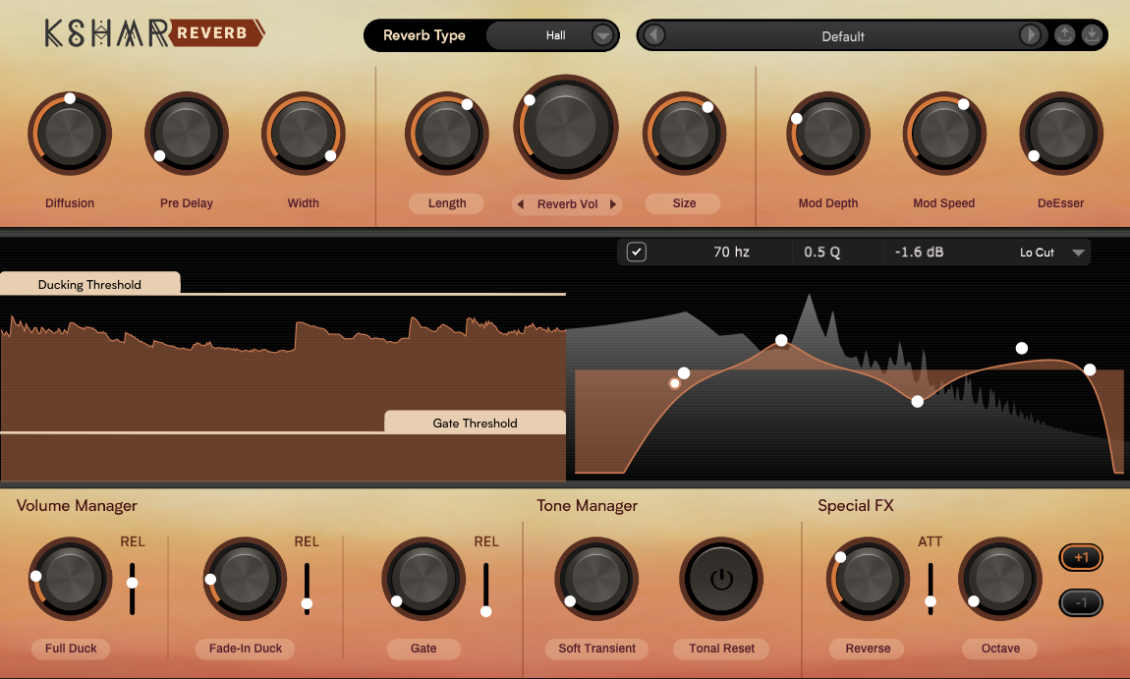
W.A Production and producer KSHMR have teamed up for KSHMR Reverb, a plugin with a number of useful extras that work well in rhythm-based productions.
Reverb is indispensable for music production. You already have a stock reverb plugin in your DAW so why bother pulling out the credit card to get another? Because, like almost every other type of plugin, all reverbs are not the same.
This is true of not only the algorithmic part – what kind of reverbs the plugin is capable of – but also its additional parameters. For modern dance music, the latter is becoming ever more important, with control over the reverb tail especially so. Enter KSHMR Reverb, an effects plugin from artist KSHMR himself and WA Production.
How Is KSHMR Reverb Different?
As with the KSHMR Essentials plugin suite, KSHMR Reverb feels like an artist-lead effect. Rather than taking a top-down approach (making the artist adapt to an engineer-developed platform), KSHMR puts the artist first.
Accordingly, there are a number of built-in extras that beat-oriented producers will likely find especially useful, namely the comprehensive ducking and gating section. Ducking acts like sidechain compression, pushing the reverb out of the way to make sonic room for the source sound. Gating truncates the reverb’s tail when it passes below a certain threshold.
By combining these two parameters, you can create all sorts of rhythmic reverb effects that effectively breathe with the beat. While it’s possible to do these things with an effects chain, having them all in one plugin is very convenient.

But we’re getting ahead of ourselves. Before we start pushing and pulling on the reverb, let’s see what kinds of reverbs KSHMR Reverb can do.
[advert]
An Overview Of KSHMR Reverb
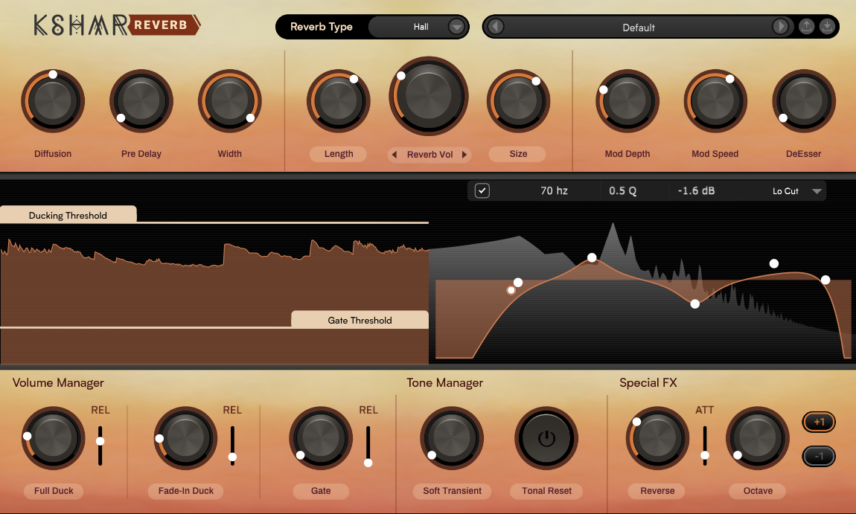
Looking at the plugin, it has three sections: basic reverb controls across the top, visual feedback in the middle, and additional controls along the bottom.
If you’ve used any reverb plugin at all, you should be immediately familiar with the top section. There are three main algorithms, plate, hall and spring. Spring is especially welcome as it’s less common than the other two. Controls on offer include Diffusion (how dense the reverb cloud is), Pre Delay, and Width. You can also control reverb length and size as well as reverb volume and mix.
These last two are nested in a single knob, which isn’t completely clear at first glance. Toggle between them to set these two parameters. There’s also modulation depth and speed for introducing movement, plus (unusually) a DeEsser, which will tame high-end fizz. For more controlled frequency shaping, use the EQ in the center.
So far, so normal. It’s the following parameters that help set KSHMR Reverb apart from many of its contemporaries. Next to the EQ is a section that you’re more likely to see on a modern compressor plugin, with a scrolling image showing peaks. Above this is a line marked Ducking Threshold, and below it, Gate Threshold. Use these to set where the ducking and gating effects start. Use the knobs in the Volume Manager section below it to control how much of the effect is applied. Additionally, you can add a fade-in to the ducking for a more gentle response, plus release amount for each.
There are two more sections worth mentioning. The first is the Tone Manager. If harsh transients are cluttering up your reverb tails, use the Soft Transient dial to smooth them out. The Tonal Reset button is particularly clever: when on, it resets the reverb with every transient, perfect for controlling the harmonic content of the reverb, such as when playing chords. Lastly, there’s the Special FX area, with a Reverse knob for tails that increase in volume rather than decrease, and an octave harmonizer with buttons for +1 and -1 octaves.
[advert]
KSHMR Reverb In Action
With all of these controls and features, let’s see how we can use it in a production setting. We’re working on a UK garage track, with samples from Splice’s UK Garage pack. We have KSHMR Reverb loaded on every track except the bass and on a send as well.
Here it is in full:
First, we put KSHMR Reverb on a second channel and send a synth loop to it. We use the Hall algorithm with plenty of length, size and width. We don’t employ any special effects as we just want a nice, long tail.
KSHMR on the send:
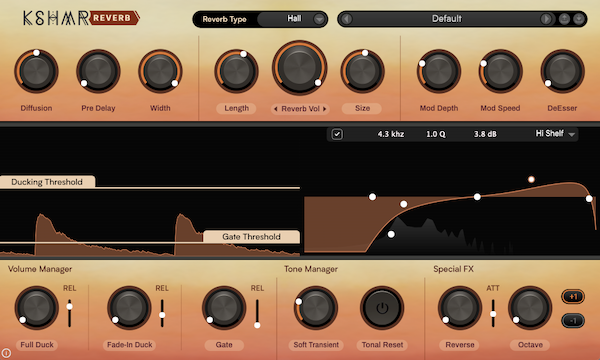
[advert]
Next, we place it across the synth channel. We want to elongate the sound but still control the length, so we use the gate effect. We also add some octave harmonics to the reverb tail. Note that you can hear it on the end as well.
Affecting the synth sound:
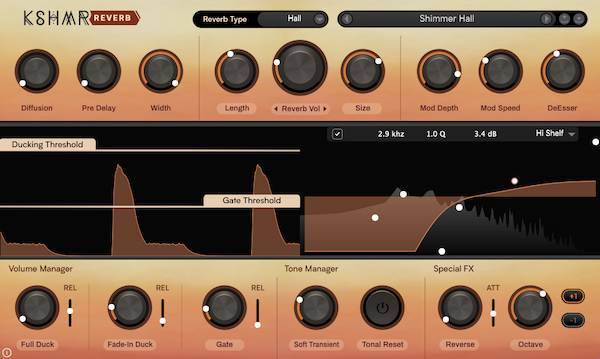
[advert]
Next, let’s fire up the modulation section to add some warbles to the reverb. Using a spring reverb algorithm with plenty of modulation, plus some ducking and gating, we can get a nice, metallic feel that works well with the source sound.
Warbly springs:
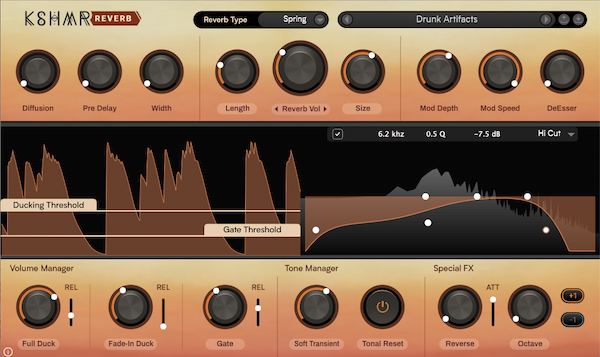
[advert]
Next, let’s see what it can do on open hats. KSHMR Reverb doesn’t have a room algorithm, which is commonly used on drum sounds, but by shortening a hall reverb we can get a similar effect. Some gating helps keep the tails tidy.
Adding space to open hats:
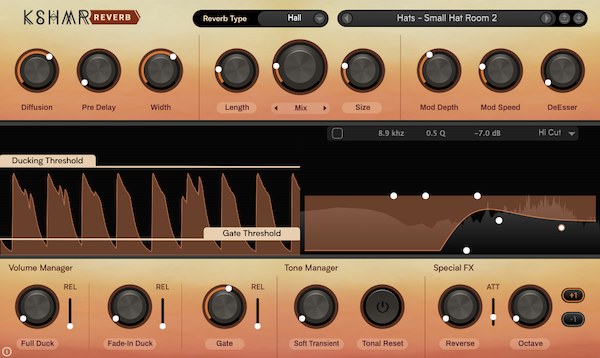
[advert]
Let’s dive deeper into the controls. Here we have KSHMR Reverb on the clap. This time, we’re using a plate reverb with ducking, gating, reverse tails and octave harmonics. We’ve also used the DeEsser to make the tails darker.
Clap reverb:
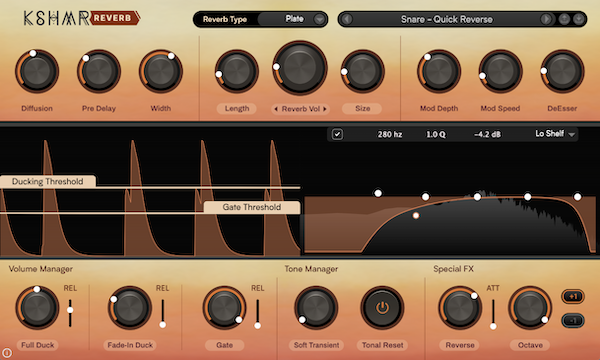
[advert]
Lastly, we do a similar thing to the full rhythm loop, using KSHMR Reverb to create a pumping, breathing effect. As we’ve got a kick in the loop, we make sure to scoop out the low-frequency information and concentrate the reverb in the upper mids with the EQ. We can work the timing of the ‘breathing’ with the Volume manager controls.
Pumping reverb:
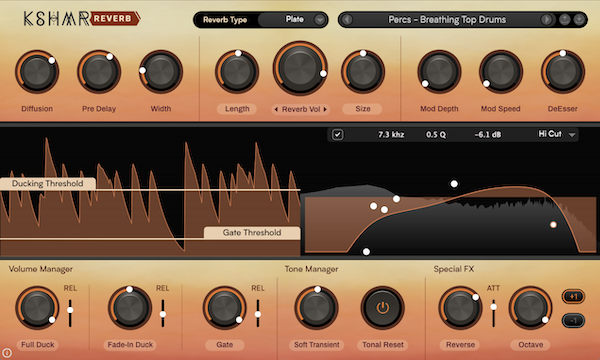
[advert]
The Final Word
KSHMR Reverb is a lot of fun. The rhythmic controls make it perfect for adding unique twists to rhythmic material like loops and other percussion. It’s also a delight to use, and the visual feedback in the compression and EQ sections makes it easy to get useful results quickly.
It has to be said that the algorithms are serviceable although compared to some, like Eventide’s Blackhole or Strymon’s BigSky, they are a little lackluster. However, KSHMR Reverb is about a quarter of the price of either of those, and neither features the kinds of rhythmic control that KSHMR Reverb does. With similar gating and ducking controls, its closest competitor is probably Baby Audio’s Crystalline, but again that’s also quite a bit more expensive.
KSHMR Reverb is affordable enough to buy for its rhythmic effects alone. While it might not be the first plugin you reach for when you need a general reverb, there are certain applications – particularly beats – where KSHMR Reverb hits the sweet spot. And at this price ($49.99, currently on sale for $19.99), it’s affordable enough to use as a special effect.
Follow Attack Magazine
[social-links heading=“follow attack magazine” facebook=”https://www.facebook.com/attackmag” twitter=”https://twitter.com/attackmag1″ instagram=”https://www.instagram.com/attackmag/” youtube=”https://www.youtube.com/user/attackmag” soundcloud=”https://soundcloud.com/attackmag” tiktok=”https://www.tiktok.com/@attackmagazine”]
attackmagazine

W.A Production and producer KSHMR have teamed up for KSHMR Reverb, a plugin with a number of useful extras that work well in rhythm-based productions.
Reverb is indispensable for music production. You already have a stock reverb plugin in your DAW so why bother pulling out the credit card to get another? Because, like almost every other type of plugin, all reverbs are not the same.
This is true of not only the algorithmic part – what kind of reverbs the plugin is capable of – but also its additional parameters. For modern dance music, the latter is becoming ever more important, with control over the reverb tail especially so. Enter KSHMR Reverb, an effects plugin from artist KSHMR himself and WA Production.
How Is KSHMR Reverb Different?
As with the KSHMR Essentials plugin suite, KSHMR Reverb feels like an artist-lead effect. Rather than taking a top-down approach (making the artist adapt to an engineer-developed platform), KSHMR puts the artist first.
Accordingly, there are a number of built-in extras that beat-oriented producers will likely find especially useful, namely the comprehensive ducking and gating section. Ducking acts like sidechain compression, pushing the reverb out of the way to make sonic room for the source sound. Gating truncates the reverb’s tail when it passes below a certain threshold.
By combining these two parameters, you can create all sorts of rhythmic reverb effects that effectively breathe with the beat. While it’s possible to do these things with an effects chain, having them all in one plugin is very convenient.

But we’re getting ahead of ourselves. Before we start pushing and pulling on the reverb, let’s see what kinds of reverbs KSHMR Reverb can do.
[advert]
An Overview Of KSHMR Reverb

Looking at the plugin, it has three sections: basic reverb controls across the top, visual feedback in the middle, and additional controls along the bottom.
If you’ve used any reverb plugin at all, you should be immediately familiar with the top section. There are three main algorithms, plate, hall and spring. Spring is especially welcome as it’s less common than the other two. Controls on offer include Diffusion (how dense the reverb cloud is), Pre Delay, and Width. You can also control reverb length and size as well as reverb volume and mix.
These last two are nested in a single knob, which isn’t completely clear at first glance. Toggle between them to set these two parameters. There’s also modulation depth and speed for introducing movement, plus (unusually) a DeEsser, which will tame high-end fizz. For more controlled frequency shaping, use the EQ in the center.
So far, so normal. It’s the following parameters that help set KSHMR Reverb apart from many of its contemporaries. Next to the EQ is a section that you’re more likely to see on a modern compressor plugin, with a scrolling image showing peaks. Above this is a line marked Ducking Threshold, and below it, Gate Threshold. Use these to set where the ducking and gating effects start. Use the knobs in the Volume Manager section below it to control how much of the effect is applied. Additionally, you can add a fade-in to the ducking for a more gentle response, plus release amount for each.
There are two more sections worth mentioning. The first is the Tone Manager. If harsh transients are cluttering up your reverb tails, use the Soft Transient dial to smooth them out. The Tonal Reset button is particularly clever: when on, it resets the reverb with every transient, perfect for controlling the harmonic content of the reverb, such as when playing chords. Lastly, there’s the Special FX area, with a Reverse knob for tails that increase in volume rather than decrease, and an octave harmonizer with buttons for +1 and -1 octaves.
[advert]
KSHMR Reverb In Action
With all of these controls and features, let’s see how we can use it in a production setting. We’re working on a UK garage track, with samples from Splice’s UK Garage pack. We have KSHMR Reverb loaded on every track except the bass and on a send as well.
Here it is in full:
First, we put KSHMR Reverb on a second channel and send a synth loop to it. We use the Hall algorithm with plenty of length, size and width. We don’t employ any special effects as we just want a nice, long tail.
KSHMR on the send:

[advert]
Next, we place it across the synth channel. We want to elongate the sound but still control the length, so we use the gate effect. We also add some octave harmonics to the reverb tail. Note that you can hear it on the end as well.
Affecting the synth sound:

[advert]
Next, let’s fire up the modulation section to add some warbles to the reverb. Using a spring reverb algorithm with plenty of modulation, plus some ducking and gating, we can get a nice, metallic feel that works well with the source sound.
Warbly springs:

[advert]
Next, let’s see what it can do on open hats. KSHMR Reverb doesn’t have a room algorithm, which is commonly used on drum sounds, but by shortening a hall reverb we can get a similar effect. Some gating helps keep the tails tidy.
Adding space to open hats:

[advert]
Let’s dive deeper into the controls. Here we have KSHMR Reverb on the clap. This time, we’re using a plate reverb with ducking, gating, reverse tails and octave harmonics. We’ve also used the DeEsser to make the tails darker.
Clap reverb:

[advert]
Lastly, we do a similar thing to the full rhythm loop, using KSHMR Reverb to create a pumping, breathing effect. As we’ve got a kick in the loop, we make sure to scoop out the low-frequency information and concentrate the reverb in the upper mids with the EQ. We can work the timing of the ‘breathing’ with the Volume manager controls.
Pumping reverb:

[advert]
The Final Word
KSHMR Reverb is a lot of fun. The rhythmic controls make it perfect for adding unique twists to rhythmic material like loops and other percussion. It’s also a delight to use, and the visual feedback in the compression and EQ sections makes it easy to get useful results quickly.
It has to be said that the algorithms are serviceable although compared to some, like Eventide’s Blackhole or Strymon’s BigSky, they are a little lackluster. However, KSHMR Reverb is about a quarter of the price of either of those, and neither features the kinds of rhythmic control that KSHMR Reverb does. With similar gating and ducking controls, its closest competitor is probably Baby Audio’s Crystalline, but again that’s also quite a bit more expensive.
KSHMR Reverb is affordable enough to buy for its rhythmic effects alone. While it might not be the first plugin you reach for when you need a general reverb, there are certain applications – particularly beats – where KSHMR Reverb hits the sweet spot. And at this price ($49.99, currently on sale for $19.99), it’s affordable enough to use as a special effect.
Follow Attack Magazine
[social-links heading=“follow attack magazine” facebook=”https://www.facebook.com/attackmag” twitter=”https://twitter.com/attackmag1″ instagram=”https://www.instagram.com/attackmag/” youtube=”https://www.youtube.com/user/attackmag” soundcloud=”https://soundcloud.com/attackmag” tiktok=”https://www.tiktok.com/@attackmagazine”]